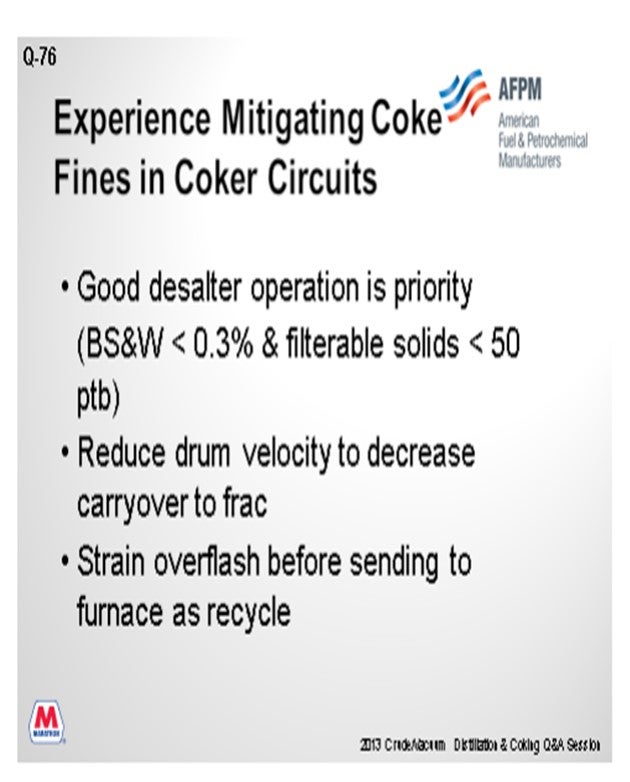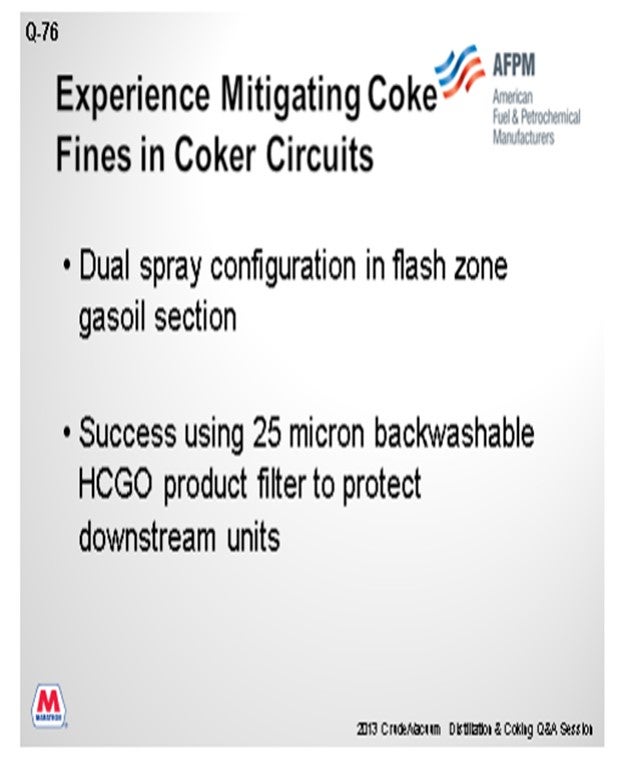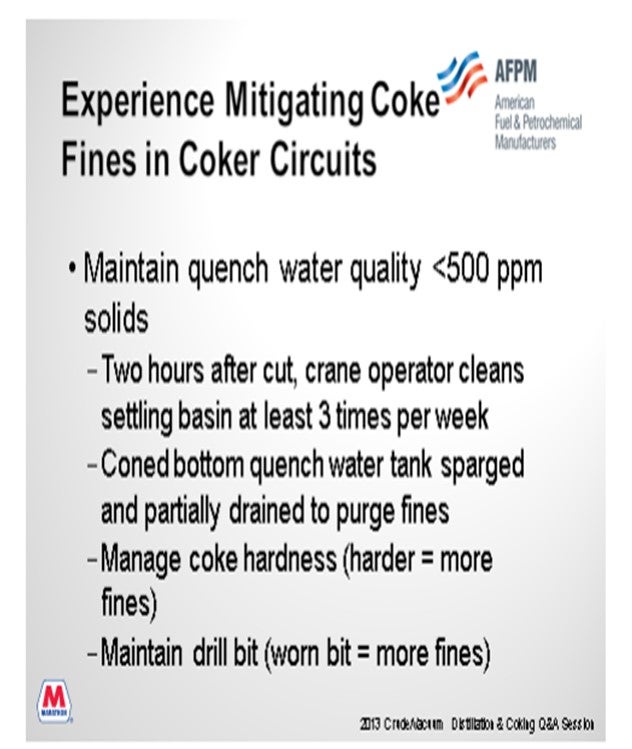Question 76: What has been the industry experience in mitigating the impact of solids in the feed or coke fines in the fractionator side draws and recycled cutting water?
SHENKLE (Flint Hills Resources, Ltd.)
We use settling mazes in the water section to minimize fines without chemical injection, and then we vacuum out individual cells on a periodic frequency to recover the fines. We also fluff our freshwater tank and circulate it when we enter cooldown to minimize the fines buildup in the tank. We do not do anything in particular to minimize fines in the feed to the unit. We have a feed surge drum and maintain coarse suction screens on vacuum tower bottoms pumps in all of our crude units, which is not necessarily as common anymore.
Regarding products, spray wash obviously helps, but it a competing factor with minimizing recycle. We use the slotted screen standpipe for minimizing material at the bottoms pumps. We also filter heavy coker gas oil with automated filters at the unit. For the combined gas oil stream at the hydrotreaters, we have typical cartridge filters.
HERLEVICH (Marathon Petroleum Corporation)
Good crude unit desalter operation is always priority and actually does affect the coker unit. The coke drum velocity is very important. Expanding coker rate increases the drum velocity and results in fines carrying over from the drum into the main frac. Try to estimate actual drum velocity as this may become the unit limit at some point. It will also be helpful to strain overflash before sending it to the furnace recycle.

In our flash zone gas oil section, we have a dual-spray configuration to capture particulates. On the heavy gas oil, we filter with 25-micron back-washable filters, which are actually quite complex contraptions. Gas oil filtration is important for the protection of downstream units. The newer gas oil filtration systems seem to run reliably, but we did struggle with older models for many years.

Waterside quality is also very important to manage. Some of the Best Practices require the crane operator to clean out the settling basin two hours after the drum cut. We typically do this three times per week. The quench water tank has a cone bottom that is sparged to suspend the solids, and then that is partially drained into the maze. Coke hardness actually impacts the fines formation: harder coke yields more fines in the cutting water. Another consideration is the drill bit and piping erosion from fines in the cutting water. Also note that worn bits result in much sloppier cutting and will tend to generate more fines.

HODGES (Athlon Solutions)
Cleaning coke fines out of your recycled cutting water is a key process that enables efficiency. As Bob mentioned, most modern designs use a maze to settle fines out. Typically, these processes cannot work without chemical addition. However, if you are having some challenges, I encourage you to contact your chemical provider. He can provide aids that, in most cases, will help settle the fines. We still occasionally run into systems designed to float the fines. So, depending on your design, you can get the appropriate chemistry to address your specific requirement.
BOB SHENKLE (Flint Hills Resources, LP)
In water, a settling maze is used without chemical addition, and solids that have settled in the maze are vacuumed out periodically from the individual cells. The freshwater tank is fluffed with water circulation during cooldown to minimize the accumulation of fines in the freshwater tank.
In feed, we do not do anything special. Our crude units have some course VTB pump suction screens in the crude units, and we have a feed surge drum upstream of the heater at the coker.
In column products, spray wash helps and also trying to minimize recycle to the heater. A slotted and screened standpipe is used to keep the solids out of the bottom's pumps.
We do filter the HCGO from the coker with automatic backflushing filters and then with conventional cartridge filters on the combined gas oil stream that goes to the hydrotreater.
EBERHARD LUCKE (CH2M Hill)
This question touches multiple issues in the coker unit and would deserve a very long and detailed answer. But to make it short, I will try to summarize the highlights. Solids in the feed have the potential to cause fouling in the pre-heat train of the coker, accumulate, and cause problems in the bottom of the fractionator, and they will cause increased fouling in the coker heater. If the problem cannot be dealt with upstream of the coker unit, the bottom circulation at the fractionation tower would be a good place to remove those solids. Unfortunately, this will not protect any pre-heat exchangers and may require a higher frequency of tube bundle cleaning or a change in heat exchanger design to better handle the solids in the feed.
Solids inside draws should mainly occur in the HCGO stream. The industry offers a number of filtration technologies that deal with this problem. Should solids also be detected in lighter streams like LCGO or even coker naphtha, a detailed study should be performed to determine the cause of this problem. In most cases, minor modifications to the tower design and/or unit operation will help eliminate this problem. Solids in the cutting water will always be a problem in units that are pushing capacity by reducing drum cycle times. The coke fines removal from the cutting water starts with managing the coke pit or coke pad. In my experience, one of the best filter media for coke fines is petroleum coke itself. So, if operators can create a barrier of coke that the cutting water flowing towards the maze has to go through, they will see that works nicely as coke fines filter.
The second issue to look at is the design and operation of the maze. Water should have sufficient residence time in the maze to allow for the settlement of coke fines which need to be removed frequently so as not to accumulate and cause coke fines carryover into the pump sump.
The last place for coke fines settling is the cutting water tank. Again, sufficient residence time needs to be provided for coke fines to settle. The bottom of the tank should be designed to allow for easy removal of accumulated coke fines, and the suction nozzle for the jet pump should be high enough above the bottom to not suck in coke fines once they accumulated in the water tank. Other technologies that can be applied to reduce the fines content of the cutting water are settlers, hydrocyclones, and customized filtration systems.
ROBERTSON (AFPM)
Those were the last remarks from the panel. Since there are no additional or comments from the audience, that concludes this Crude session. I want to thank the panelists. They did a great job. Thanks to Harold Eggert, the coach for this group. Please fill out the survey forms and deposit them in the box in the back. They are really important. I want to also thank you guys. The lunch is in the Exhibit Hall at 12:00. We finished a little early, so I am sure you are happy about that. Thank you very much.